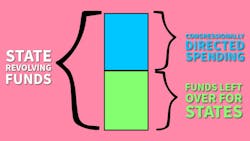Water leaders urge Congress to fully fund SRF programs for water
In a joint Feb. 15 letter to the Congressional Appropriations Committee, the 23 organizations in the water industry have urged the committee to fully fund the Clean Water and Drinking Water State Revovling Funds for FY2024.
In July, E&E News reported that lawmakers in the House proposed cuts to Interior-Environment Approrpriations, which included approrprating $995.6 million for Clean Water SRF and the same allotment for Drinking Water SRF. This would be a reduction of $1.77 billion from the requested amount from the White House. A similar letter to the one from Feb. 15 was issued in August of last year, according to a report from Water Finance & Management.
Three reasons to fully fund CWSRF and DWSRF
The Feb. 15 letter — which is co-signed by Water Environment Federation, American Water Works Association, National Associatoin of Clean Water Agencies and others — to the chairs and vice chairs of both the U.S. House and U.S. Senate Appropriations Committees calls for full funding of the programs at $3 billion each. The organizations listed three reasons for the necessity of this funding:
- Clean water is foundational to protecting public health.
- Demand for SRF financing for water and wastewater systems has increased exponentially.
- Failure to fully fund will jeopardize the current and projected pipeline of water and wastewater infrastructure projects.
The letter provides its most extensive argument in the 2nd listed reason, noting first and foremost that water infrastructure projects have increased 40% in the last five years alone. The Wastewater Digest 2023 State of the Industry Report found that 84% of industry professionals expect an increase in materials pricing in 2024 and 87% expect bid prices to continue to rise as well.
Water industry leaders pointed to historic inflation levels and lingering impacts of pandemic pricing as reasons for the 40% increase as well as regulatory pressures and rising interest rates.
"In addition to repairing and replacing aging infrastructure, complying with more stringent
water quality standards requires new investments in sophisticated and often expensive
treatment technologies," the Feb. 15 joint letter states. "Higher construction costs are compounded by higher financing costs from rising interest rates on the municipal market. The cost of borrowing has become a barrier to needed investment in water infrastructure. "
In relation to its third point, coalition of water leaders wrote that Infrastructure Investment and Jobs Act funding acted as a backfill for previous cuts to annual appropriations for water infrastructure.
"Additionally, more than half of the federal unding in the IIJA can't be used to repair, replace or improve aging infrastruucture, which is desperately needed," the letter states, "and nearly half of the funding available for those projects must be used as grants or principal forgiveness, which limits eligibility."
Congressionally Directed Funding is reducing available SRF money
In addition to the collective action of the water organizations, the National Governor's Association also issued a letter last September to Congress urging support for fully funding the CWSRF and DWSRF programs. NGA explained the value of SRFs, which is quoted verbatim below.
The SRFs were established to provide funding to states and territories to make low-interest loans for water infrastructure projects. The revolving loan programs, which have operated successfully for decades, are state-run and federally-financed through annual capitalization grants to each state and territory. Key to the historic success of SRFs has been the ability of states and territories to leverage federal funding to finance low-interest loans and recycle loan repayments to maximize the impact of those initial federal investments.
NGA notes that the underlying issue for this is related to Congressionally Directed Spending (CDS), also known as earmarks. Historically, earmarks were funded through a separate appropriation from the CWSRF and DWSRF buckets, but since 2022, that has changed.
CDF is now a part of the SRF appropriations buckets, and that funding is issued as a grant, not a loan. This means that Congress people can direct funding from the SRF appropriations directly to projects in their territories and districts. In effect, this reduces the total pool of SRF money that is then issued to the states to be used in their normal SRF application vetting, prioritization and issuance processes. And because the money is issued as a grant, the low interest rates are not collected and returned to grow the SRF program over time as intended.
"Even with CDS, 45 states and territories have received less in total water infrastructure funding in at least one of the last two fiscal years, resulting in a $2.3 billion cut to annual federal funding for state-administered SRF projects (42%). For example, Kentucky’s SRF funding has been cut by more than half over this time period," the NGA letter from September reads.
Wastewater Digest will be following the appropriations as they occur, and updates will follow as news develops.
About the Author
Bob Crossen
Bob Crossen is the vice president of content strategy for the Water and Energy Groups of Endeavor Business Media, a division of EndeavorB2B. EB2B publishes WaterWorld, Wastewater Digest and Stormwater Solutions in its water portfolio and publishes Oil & Gas Journal, Offshore Magazine, T&D World, EnergyTech and Microgrid Knowledge in its energy portfolio. Crossen graduated from Illinois State University in Dec. 2011 with a Bachelor of Arts in German and a Bachelor of Arts in Journalism. He worked for Campbell Publications, a weekly newspaper company in rural Illinois outside St. Louis for four years as a reporter and regional editor. Crossen can be reached at [email protected].


